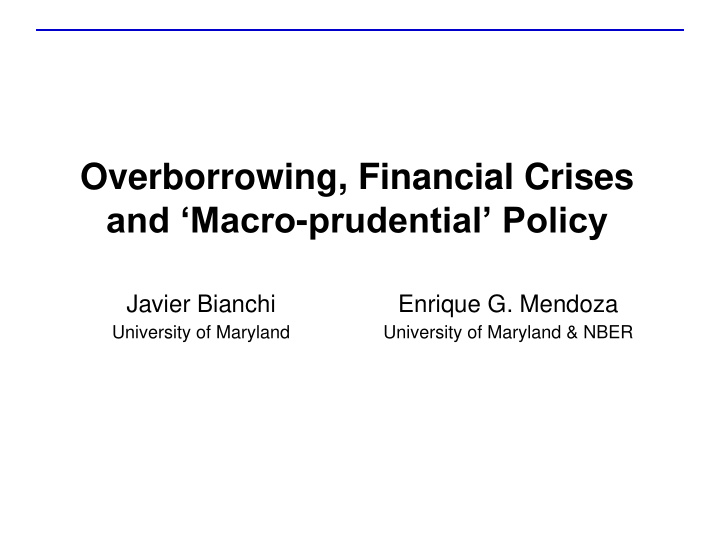



Overborrowing, Financial Crises and „Macro - prudential‟ Policy Javier Bianchi Enrique G. Mendoza University of Maryland University of Maryland & NBER
The case for macro-prudential policies • Credit booms tend to be followed by deep recessions, asset price crashes, and often financial crises – Credit booms occurred with 2.2% frequency in 1960-2006, and about 1/2 ended in banking crisis (Mendoza & Terrones (08)) – …in this sense the 2008 - 09 global crisis had a “typical” pattern • Macro-prudential policy (MPP) has a clear goal: to prevent “overborrowing” at a macro level by affecting behavior ex ante • …but specifics of MPP design are less clear – Overborrowing is vaguely defined or used as a value judgment – Normative/quantitative macro models of MP are scarce
Two key quantitative questions • Can a micro-level financial friction cause systemic (macro) overborrowing? – Can it cause /explain financial crises or affect business cycles? – Sound MPP starts with a “good” model of crises – Similar question as in the broad literature on financial frictions • Is macroprudential policy effective to prevent overborrowing and financial crises? – What are its main features? – How does it affect incidence and magnitude of financial crises? – What are its effects on asset pricing behavior (excess returns, Sharpe ratios, price of risk)?
What we do in this paper • Answer the questions using a DSGE model with a collateral constraint that limits debt to a fraction of market value of assets. – Examine differences between a decentralized eq. (DE) and a social planner (SP) subject to IDENTICAL credit possibilities. • The credit constraint plays two key roles: 1. Triggers Fisher's debt-deflation feedback mechanism, which amplifies effects of negative shocks causing deep recessions 2. Introduces a pecuniary externality via price of collateral assets (in “good times” agents do not internalize that lower leverage weakens Fisherian deflation in “bad times”) A planner that reduces debt ex ante improves welfare.
Agents not internalizing home prices
Main findings 1. DE and SP yield similar average debt and leverage 2. …but crises are larger and more frequent in DE – Probability of financial crises increases by a factor of 3. – Asset prices fall 17 ppts more (24% v. 7% for SP). – Credit and consumption fall about 10 ppts more – Overall cyclical variability is also higher 3. Mean excess return and Sharpe ratio rise by factors of 6 and 10, and market price of risk increases 81%. 4. SP’s allocations implementable with state -contingent taxes on debt (1% on average, positively corr. with leverage) and on dividends (-0.4% on average)
Main elements of the model • Inter-period non-state-contingent debt for smoothing & intra-period debt for working capital (WK) • Collateral constraint limits total debt to fraction of market value of physical assets (in fixed supply) • Production with labor and physical assets • WK has zero financing cost but requires collateral • Standard TFP shocks only (crises with realistic features result from endogenous amplification) • GHH preferences remove wealth effect on labor supply
Representative firm-household problem in the decentralized economy • Maximize: s.t. budget constraint and collateral constraint
Asset pricing conditions • Excess asset returns: • Forward solution for asset prices:
Constrained Social Planner's problem Taking as given
Pecuniary credit externality • DE‟s private marginal utility cost of borrowing: • SP‟s social marginal utility cost of borrowing: where amplifies and mitigates effects of adverse shocks
Optimal macro-prudential policy • Decentralize planner’s eq. with state contingent taxes • Tax on debt implements SP’s bond decision rule: • Tax on dividends makes asset prices equivalent:
Calibration
Decision rules for bonds in low TFP state l.r. prob: l.r. prob: l.r. prob: DE 27% DE 4% DE 70% SP 29% SP 2% SP 69%
Equilibrium land prices in low TFP state
Debt dynamics: amplification effects b t+1 b t+1 =b t b t
Asset pricing moments
Endogenous “fat tails” in CDF of returns
Conclusions • Study of overborrowing, credit externalities and macro-prudential policy in DSGE model of business cycles and asset prices. • Collateral constraint introduces systemic credit externality that increases magnitude and incidence of financial crises, mean excess returns, volatility of returns and Sharpe ratios • Optimal taxes on debt and dividends neutralize credit externality, but implementation is likely to be difficult: – State-contingent policies that require detailed information on debt and leverage of a large set of economic agents – Taxing dividends during crises politically difficult, but selective implementation reduces welfare
Recommend
More recommend